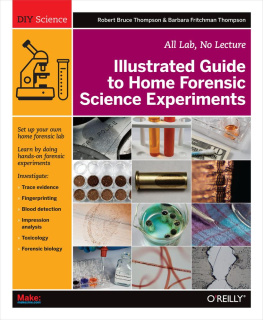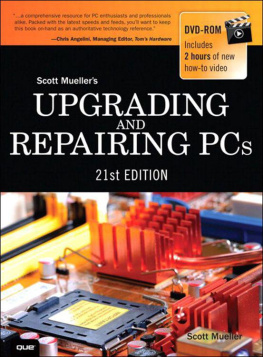Supplemental files and examples for this book can be found at http://examples.oreilly.com/9780596008666/. Please use a standard desktop web browser to access these files, as they may not be accessible from all ereader devices.
All code files or examples referenced in the book will be available online. For physical books that ship with an accompanying disc, whenever possible, weve posted all CD/DVD content. Note that while we provide as much of the media content as we are able via free download, we are sometimes limited by licensing restrictions. Please direct any questions or concerns to .
Foreword
Why do books have foreword sections?
I suppose one reason is to associate the foreword writer's name with the book in the hopes that it will increase sales. That's not likely in this case. The last time I did a foreword for one of Bob and Barbara Thompson's books ( Building The Perfect PC ), O'Reilly had not one word about my foreword on the front or back cover, and since the book has deservedly sold very well indeed it obviously didn't need my help. Besides, if you know who I am you probably know who Bob Thompson is, since I tend to rely on him for hardware advice. A lot.
Another reason for a foreword is to add one last dab of persuasion if you have the book in your hands and you're wondering if you should buy it. But that can't be right either. You're an intelligent person, and you already know I endorse the book and think you should buy it, or I wouldn't be in here.
Well, enough on that. This is, unsurprisingly, an endorsement, and yes, if you're thinking of upgrading your old (or even your almost new) computer, investing in this book before you start is a very good idea. Not only will the Thompsons tell you how to do just about anything a sane person would want to do to upgrade his computer, but they will tell you whether or not you ought to bother.
A few years ago I would have told you not to bother at all. For not a lot more than the cost of upgrading your old system, you could build a new one and network to the old. That's still good advice, sometimes, depending on the computers involved, and even more on what you intend to do with the machine(s). For example, if what you want is a screaming games machine, don't even think of upgrading unless you have a very late model system and you're just tweaking. If you want a screaming games machine and you don't have a pretty good one now, it's cheaper to start over. Cheaper is a relative term: if you insist on the very latest for a screaming games machine, there won't be anything cheap about it. In any event, for that you'll need Thompson's other book, Building The Perfect PC .
Even then, though, you may want this one. If you get a new machine and network to the old one, you may decide that disk drives are faster than tape, and the right way to backup your system is to have a big box of drives and back up to that. This book will tell you how to do enough upgrade to your old machine to make it an excellent backup system host.
And if you don't want a screaming games (or CAD) machine and you're not doing hydrodynamics simulations or something else that eats computing cycles, chances are that you have all the machine you need, and upgrading will be worth your effort. You can add USB 2.0, FireWire, Serial ATA disk drives, and a passel of other new features, and no one including you will even know you have an upgrade rather than a new machine.
This book will tell you all of that, and a lot more. It will tell you if you should upgrade, and if so, what to, depending on what you want the machine to do; and once you decide what you want to do, it will tell you how to do it. If this is not your first Thompson book, you already know that it's written in clear English, understandable, written by someone who never went to that school that teaches how to prove you've explained something even though no one has understood one word you said. Graduation from that school seems to be a requirement for employment in writing Microsoft HELP files, but the Thompsons never attended it. If this is your first Thompson book, you're in for a pleasant surprise, particularly if what you're used to is graduates of that school.
If you need this book, you need it badly; and if you're contemplating upgrading, or deciding whether to upgrade or buy a new computer, you definitely need it.
Jerry Pournelle
Chaos Manor
Hollywood, 2005
Preface
We live in a throw-away society. Disposable this, recyclable thatfew consumer products nowadays are designed to be fixable, let alone upgradable. PCs are an exception, although you wouldn't know it from reading the mainstream media. While we were writing this book, we were flabbergasted to read an article in a respected publication that seriously suggested the best cure for a spyware-infested PC was to throw it out and buy a new one!
The article did have a valid point, though. Paying someone to disinfect a spyware-laden system can easily cost hundreds of dollars. Similarly, one of our readers was quoted a price of more than $200 to replace a failed power supply in a two-year-old system. The problem, of course, is that parts are cheap but skilled labor is expensive. In most parts of the country, PC technician time is billed at $60 to $100 per hour. At that rate, it doesn't take long for the bill to add up to the cost of a new PC. Fortunately, you can bypass those high labor costs by doing the work yourself, and you needn't have special equipment or be a computer wizard to do it. If you can change the oil in your car or hook up a DVD player, you can repair or upgrade your own PC.
You won't be alone, either. If you visit a local big-box store, you'll find aisle upon aisle of PC componentsmotherboards, processors, drives, memory, power supplieseverything you need to repair or upgrade your current system. The trick, of course, is knowing what needs to be done and how to do it. That's what this book is about.
Organization of This Book
Each chapter of this book is devoted to one topic, and is self-contained. The first three chapters provide detailed advice on maintaining, securing, and working on your system. They describe the tools and software you'll need, explain basic procedures like installing expansion cards and first-level troubleshooting, and detail the tips and tricks we've learned during 20 years of working on PCs. These chapters include:
| , Introduction |
| , Working on PCs |
| , System Maintenance |
The second group of chapters covers the core components of your PCthe motherboard, processor, and memory. These chapters describe in detail the important characteristics of each of these components; how to choose compatible, cost-effective replacement or upgrade components; how to install and configure them; and how to troubleshoot problems. This group includes the following chapters:










